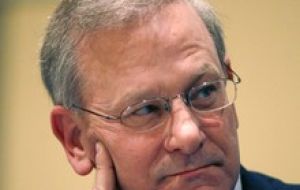MercoPress. South Atlantic News Agency
Fed leaves rates unchanged in context of moderate growth and unemployment
 Kansas City Fed President Thomas Hoenig believes exceptionally low rates create risk of new financial bubbles
Kansas City Fed President Thomas Hoenig believes exceptionally low rates create risk of new financial bubbles The United States Federal Reserve left its key interest rate near 0% once again Tuesday and said rates should stay this low for the foreseeable future. In its release the Federal Open Market Committee, FOMC, policymakers repeated their prediction that economic conditions are likely to result in “exceptionally low levels of the federal funds rate for an extended period”.
However some economists, including Kansas City Fed President Thomas Hoenig believe the Fed needs to drop that promise. Hoenig voted against keeping this language in place for the second straight meeting. He and some Fed critics worry that the central bank could be creating new bubbles in financial markets by keeping rates so low for such a long time.
The so-called fed funds rate, a benchmark that determines the interest paid by consumers and businesses on a wide variety of loans, has been near 0% since December 2008, as the central bank worked to spur greater lending and economic activity.
Besides low interest rates, the Fed has pumped trillions of dollars into the US economy over the last two years through the purchases of mortgage-backed securities, long-term Treasury and special lending programs.
Most of those programs are at or near an end. The Fed said it is close to completing its planned purchases of 1.25 trillion dollars in mortgage-backed securities which it started in November 2008. It has long targeted the end of the first quarter for the completion of this program. But some economists are worried that mortgage rates will start to rise once the Fed is no longer buying mortgages.
On the positive side the FOMC release said data suggests that economic activity has continued to strengthen and that the labour market is stabilizing; household spending is expanding at a moderate rate but remains constrained by high unemployment, modest income growth, lower housing wealth, and tight credit, and business spending on equipment and software has risen significantly.
However, “investment in non-residential structures is declining, housing starts have been flat at a depressed level, and employers remain reluctant to add to payrolls. While bank lending continues to contract, financial market conditions remain supportive of economic growth. Although the pace of economic recovery is likely to be moderate for a time, FOMC anticipates a gradual return to higher levels of resource utilization in a context of price stability”.
The Fed said there is no threat of inflation in the near-term: “with substantial resource slack continuing to restrain cost pressures and longer-term inflation expectations stable, inflation is likely to be subdued for some time”.
Finally the release points out that voting against the policy action was Thomas M. Hoenig, who believed that “continuing to express the expectation of exceptionally low levels of the federal funds rate for an extended period was no longer warranted because it could lead to the build-up of financial imbalances and increase risks to longer-run macroeconomic and financial stability”.
The US economy resumed growth in the second half of last year, and expanded at a robust 5.9% annual clip in the final three months of the year. But unemployment rate remains at 9.7%.




Top Comments
Disclaimer & comment rules-

Read all commentsWe have to get used to the idea of a new USA. A USA of loosers and clowns that believe themselves as the police of the world. They are just the future b*tch of Russia, Brasil and India. Nicholas will eat argentine food, will use brazilian oil, will play chess in a russian game table and will dress in a chinesse outfit. lol
Mar 16th, 2010 - 11:34 pm 0Commenting for this story is now closed.
If you have a Facebook account, become a fan and comment on our Facebook Page!